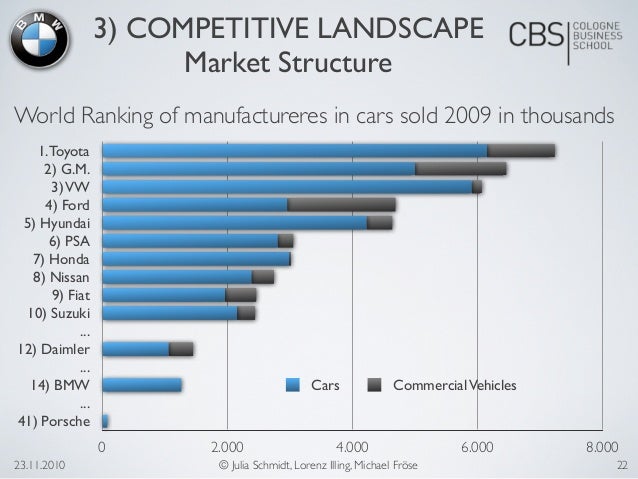China Market Analysis: The Struggles Of BMW, Porsche, And Other Foreign Auto Brands

Table of Contents
Intense Domestic Competition from Chinese Automakers
The rise of domestic Chinese automakers is arguably the biggest challenge facing foreign brands. These companies are no longer simply offering budget-friendly alternatives; they're producing technologically advanced, stylish, and desirable vehicles that resonate deeply with Chinese consumers.
Rise of Domestic Brands
The success of Chinese electric vehicle (EV) manufacturers like BYD, Nio, and Xpeng is undeniable. Their rapid growth is fueled by innovative designs, competitive pricing, and a strong understanding of the local market.
- BYD's success: BYD's range of EVs, particularly the Han and Tang models, have captured significant market share, challenging established foreign brands.
- Nio's innovative approach: Nio's battery-swapping technology and focus on premium features have attracted a loyal customer base.
- Xpeng's advanced technology: Xpeng's integration of advanced driver-assistance systems (ADAS) and smart features has made it a formidable competitor.
These brands leverage strong national appeal, appealing to a sense of patriotism and supporting local industry, a powerful factor in the Chinese market. They often offer superior features at more competitive price points, directly impacting the sales of foreign competitors.
Government Support for Domestic Industry
The Chinese government actively supports its domestic auto industry through various policies and subsidies, creating an uneven playing field for foreign players. This support manifests in several ways:
- Tax breaks and subsidies: Generous tax incentives and direct subsidies are offered to Chinese EV manufacturers, reducing their production costs and allowing them to offer more competitive pricing.
- Preferential access to resources: Domestic brands often receive preferential access to crucial resources like battery raw materials and charging infrastructure.
- Investment in R&D: The government invests heavily in research and development for the domestic auto industry, fostering technological advancements and innovation.
These policies significantly impact foreign automakers' ability to compete on price and technology, hindering their market penetration and overall success.
Shifting Consumer Preferences and Demands
The Chinese automotive market is dynamic, with consumer preferences shifting rapidly. Foreign brands need to be agile and responsive to stay relevant.
Growing Preference for Electric Vehicles (EVs)
The EV market in China is booming. Consumer demand for electric vehicles is soaring, driven by government incentives, environmental concerns, and technological advancements.
- Market share: EVs account for a substantial and rapidly growing percentage of the overall Chinese auto market.
- Leading EV brands: Chinese EV brands dominate the sales charts, leaving foreign automakers scrambling to catch up.
Foreign brands face a significant challenge in transitioning to EV production at a scale and speed that can compete with their Chinese counterparts. The technological expertise and investment required for effective EV production pose a considerable hurdle.
Focus on Technology and Digital Features
Chinese consumers place a high value on advanced technology and digital features in their vehicles. This extends beyond basic infotainment systems; it encompasses ADAS, connectivity, and seamless integration with digital lifestyles.
- ADAS features: Advanced driver-assistance systems, including lane-keeping assist, adaptive cruise control, and autonomous parking, are highly sought-after.
- Connectivity features: Seamless smartphone integration, over-the-air updates, and access to a wide range of digital services are crucial.
- Voice assistants and AI: Voice-activated controls, AI-powered features, and personalized user experiences are key differentiators.
Foreign brands need to significantly enhance their technological offerings and prioritize digital integration to attract and retain Chinese customers.
Regulatory Hurdles and Market Access Challenges
Navigating the regulatory landscape in China presents significant obstacles for foreign automakers. These challenges add complexity and cost to market entry and ongoing operations.
Import Tariffs and Taxes
High import tariffs and taxes significantly increase the cost of foreign vehicles, making them less competitive compared to domestically produced alternatives. This price disadvantage directly impacts market share and profitability.
- Tariff rates: Import duties on vehicles vary, but they generally add a substantial amount to the final price.
- Impact on pricing: The higher cost of imported vehicles limits their accessibility to a wider consumer base.
Stringent Emission Standards and Regulations
China has implemented increasingly stringent emission standards and environmental regulations, requiring foreign automakers to make substantial investments in research and development to comply.
- Compliance costs: Meeting these regulations necessitates significant investments in new technologies and production processes.
- Technological adaptation: Foreign brands need to adapt their vehicle designs and manufacturing processes to meet the specific requirements.
Navigating Complex Bureaucracy
The bureaucratic hurdles involved in market entry, obtaining licenses, and establishing distribution networks in China are substantial. This involves navigating complex regulations, obtaining numerous permits, and dealing with lengthy approval processes.
- Licensing and permits: Securing the necessary licenses and permits can be a time-consuming and costly endeavor.
- Establishing distribution networks: Building an effective distribution network requires significant investment and coordination.
Conclusion: Overcoming the Challenges in the Chinese Automotive Market
Foreign auto brands face a formidable challenge in the Chinese automotive market. The intense competition from rapidly advancing domestic brands, evolving consumer preferences focused on EVs and advanced technology, and complex regulatory hurdles all contribute to the difficulties. Successfully navigating this market requires a deep understanding of local consumer demands, strategic partnerships, significant investment in R&D, and a proactive approach to regulatory compliance.
Key Takeaways: The Chinese auto market, while expansive, requires a tailored strategy. Ignoring the rising domestic competition, the preference for EVs and technological advancements, and the regulatory landscape will almost certainly result in failure.
Call to Action: Deepen your understanding of the China automotive market analysis and navigate the challenges successfully. Develop a robust strategy encompassing technological adaptation, consumer preference understanding, and effective regulatory compliance to thrive in this dynamic and competitive market.

Featured Posts
-
 String Of Car Break Ins Reported Across Elizabeth City Apartment Complexes
May 09, 2025
String Of Car Break Ins Reported Across Elizabeth City Apartment Complexes
May 09, 2025 -
 The Snl Impression That Upset Harry Styles
May 09, 2025
The Snl Impression That Upset Harry Styles
May 09, 2025 -
 Tien Giang Xu Ly Nghiem Vu Bao Mau Bao Hanh Tre Em Va Ngan Chan Tuong Tu
May 09, 2025
Tien Giang Xu Ly Nghiem Vu Bao Mau Bao Hanh Tre Em Va Ngan Chan Tuong Tu
May 09, 2025 -
 Nyt Crossword Solutions Strands Theme And Hints For April 12 2025
May 09, 2025
Nyt Crossword Solutions Strands Theme And Hints For April 12 2025
May 09, 2025 -
 Spring Fashion Elizabeth Stewart X Lilysilk Collaboration Unveiled
May 09, 2025
Spring Fashion Elizabeth Stewart X Lilysilk Collaboration Unveiled
May 09, 2025
Latest Posts
-
 Free Streaming Sylvester Stallone In The Action Thriller Armor
May 12, 2025
Free Streaming Sylvester Stallone In The Action Thriller Armor
May 12, 2025 -
 Sylvester Stallones Directing Career The One Film He Didnt Star In
May 12, 2025
Sylvester Stallones Directing Career The One Film He Didnt Star In
May 12, 2025 -
 Watch Sylvester Stallones Action Thriller Armor Free This Month
May 12, 2025
Watch Sylvester Stallones Action Thriller Armor Free This Month
May 12, 2025 -
 Coming Home 1978 Sylvester Stallones Unchosen Path To Oscar Glory
May 12, 2025
Coming Home 1978 Sylvester Stallones Unchosen Path To Oscar Glory
May 12, 2025 -
 Sylvester Stallone Action Thriller Armor Now Streaming Free This Month
May 12, 2025
Sylvester Stallone Action Thriller Armor Now Streaming Free This Month
May 12, 2025
